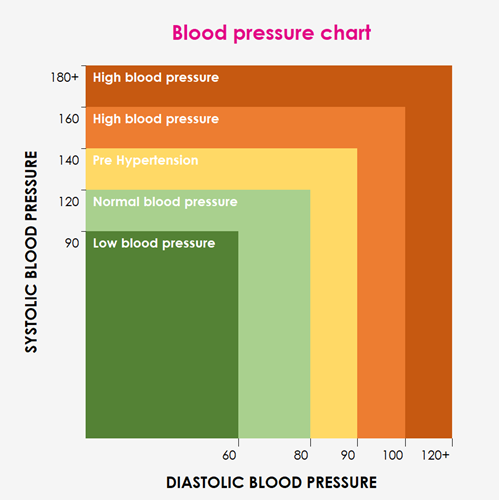What is a normal blood pressure reading?
Do you know what your ideal blood pressure reading should be?
Blood pressure is the force at which your heart pumps blood around the body and is recorded with 2 numbers. The higher of the numbers (systolic) is an indication of when the heart is pumping the lower number (diastolic) is the resistance to the blood flow in the blood vessels. It’s widely publicised that high and low blood pressure can induce health problems, but what about healthy or correct blood pressure?
What is the ideal blood pressure?
Blood pressure readings are calculated using one number ‘over’ another: systolic blood pressure over diastolic. You can calculate these with our blood pressure calculator tool.
The blood pressure monitor shows measurements in millimetres of mercury, appearing as ‘mmHg’. Everyone’s ideal blood pressure will be slightly different, this could be secondary to your age, ethnicity or potential or current health conditions, you would need to discuss with a medical professional as to what’s safe and healthy for you.
The normal blood pressure range for adults comes in between 90/60mmHg and 120/80mmHg. This means that anything below 90/60mmHg mark constitutes low blood pressure (hypotension), while anything above 140/90mmHg indicates high blood pressure (hypertension) as this is the threshold where a medical professional would actively monitor your blood pressure range.
Knowing these numbers can help make you more aware of your health, and may help you to stay on top of keeping within a normal blood pressure range.
What is systolic blood pressure?
When it comes to understanding blood pressure, it can help to take a more in-depth look at the numbers that make up the final measurement.
The first number in blood pressure readings is your body’s systolic blood pressure. Systolic pressure refers to the pressure that your heart pushes blood out - it measures the pressure on your arteries, caused by the contractions of your beating heart as it pushes blood around your body. 120 is the ideal systolic blood pressure measurement, while anything below that indicates low blood pressure. A reading between 120 and 140 could be an indication that your blood pressure isn't controlled whilst anything more than 140 indicates cause for concern.
What is diastolic blood pressure?
The second number in a blood pressure measurement is your diastolic blood pressure, which indicates the pressure in your arteries between heartbeats.
A normal diastolic blood pressure usually comes in at around 80 or less, while a reading between 80 and 89 is considered normal, but higher than ideal. Repeated blood pressure readings of 90 or higher are where cause for concern may start, as they can be indicative of high blood pressure.
Blood pressure chart
Once you know your systolic and diastolic blood pressure numbers, you can use a blood pressure chart to see what they mean, and if your blood pressure is within a normal range.
To use the blood pressure chart, simply find your top number (systolic) on the left side of the blood pressure chart, and match this to your diastolic blood pressure number on the horizontal axis. Look at the part where the two lines meet on the chart to find out if your reading falls under a normal blood pressure range, or is actually considered higher or lower.

Blood pressure reading chart
What do your blood pressure readings mean?
While there is no right blood pressure reading, it is important to know and understand your blood pressure range, so any potential problems can be detected early.
Lower than 90/60mmHg - Risk of hypotension. This is a lower than normal reading but is not necessarily ground for high concern. We recommend seeing a GP if someone continuously gets symptoms of dizziness or nausea, as this may be a sign of hypotension.
91/61mmHg to 120/80mmHg - Normal blood pressure. Blood pressure within this range could be called ideal blood pressure. It indicates little to no risk of serious complications arising such as a stroke or heart attack. It’s important to maintain this level of blood pressure to prevent the health risks associated with high blood pressure.
121/81mmHg to 140/90mmHg – Pre-Hypertension. Although in many cases pre-hypertension is completely normal, however, if you have certain health conditions or from certain ethnicities, this may increase the risk of suffering from a stroke. You may need to look for ways to lower your blood pressure.
141/91mmHg to 160/100mmHg – Stage 1 Hypertension. High blood pressure may increase the risk of suffering from a stroke or heart attack. In this instance, you should ideally try to lower your blood pressure to a normal level.
161/101mmHg to 180/120mmHg – Stage 2 Hypertension. If your blood pressure falls within this range it indicates a high degree of risk to your future health, it is extremely important to try and get your blood pressure down.
You can also use our blood pressure calculator, to find out more about what your numbers mean and what your next steps should be.
What is high blood pressure?
High blood pressure is also known as hypertension, and at its worst, could put strain on your blood vessels, causing problems in your heart, brain, kidneys and eyes. Persistently high blood pressure may, in the worst case scenario, lead to serious health problems, including heart disease, kidney disease and strokes.
However, high blood pressure can be a largely symptomless problem, with the occasional exception of frequent headaches. This means that prevention could be better than cure: proactively avoiding some of the main causes of high blood pressure.
Some medical conditions may not show any symptoms, high blood pressure can be one of those and could therefore affect your quality of life in the future. Therefore, it’s important that you monitor your blood pressure closely and ensure it’s correct.
What is low blood pressure?
Low blood pressure (also known as hypotension) may sounds scary but is not always a cause for concern. If you’re suffering from low blood pressure you may experience a few mildly unpleasant symptoms, including dizziness, light-headedness and nausea. However, you can help these pass by doing things like standing up slowly, factoring more salt into your diet and staying hydrated.
Very low blood pressure can also impact your kidneys, heart and sometimes cause injury as you might be more at risk of falling or fainting.
How often should you measure your blood pressure?
NHS recommends for adults aged 40 years old and over to have their blood pressure checked at least every 5 years. If you’re at an increased risk of high blood pressure, you should ideally have your blood pressure readings taken once a year.
Having a blood pressure test is easy and provides you with the information to improve your lifestyle therefore preventing ill health. The reading my also reassure you that you are keeping your levels at a healthy range. To test your blood pressure, you can book an appointment to see your GP, have your reading taken at a pharmacy, or buy an at-home testing machine from your local pharmacy.
About our healthcare
Benenden Health provides affordable private healthcare for everyone, giving you access to services such as our 24/7 GP Helpline and Mental Health Helpline straight away. Once you’ve been a member for six months you can request access to diagnostic consultations and tests. Benenden Health members can also take advantage of a discounted price on health assessments through our partners, Bluecrest Health Screening.
You'll also have access to a wealth of health and wellbeing articles, videos and advice on a range of health issues.
Medically reviewed in March 2024.


